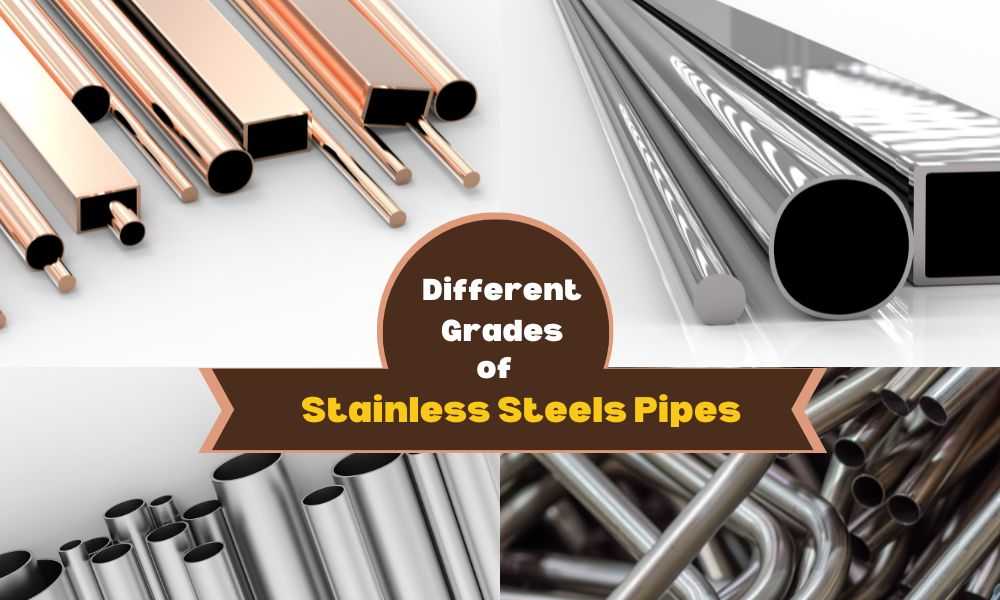What are the Different Grades of Stainless Steel Pipes Available In The Market?

Stainless steel is a very adaptable substance that is employed in a variety of goods and applications. But did you know that stainless steel pipe comes in a variety of varieties? Selecting the kind that is appropriate for your particular project or product may be easier if you are aware of the differences between these sorts.
The stainless steel used in pipework comes in a variety of varieties. Due to its outstanding corrosion resistance qualities, stainless steel is employed in process industries second only to carbon steel.
With a minimum chromium concentration of 10.5% or higher and a maximum carbon percentage of less than 1.20%, stainless steel is a form of alloy steel.
Stainless steel is incredibly corrosive-resistant and ductile. Because of the development of a non-reactive chromium oxide (Cr2O3) coating on the surface, stainless steel becomes corrosion-resistant. The metal surface is strongly adhered to by this layer, creating a barrier that prevents corrosion.
What are the Different Grades of Stainless Steel Pipes?
Due to their strength, longevity, and resistance to corrosion, stainless steel pipe is used in a variety of applications. They come in a variety of grades, each with special qualities and traits. The many stainless steel pipe grades that are offered on the market will be covered in this piece of writing.
Grade 304 Stainless Steel Pipes:
One of the most commonly used kinds of stainless steel pipes is grade 304. Chromium and nickel are included in this austenitic stainless steel. The versatility, toughness, and corrosion resistance of grade 304 stainless steel pipes make them ideal for a variety of applications, including food processing, chemical processing, and pharmaceutical production. They are also widely used in the building sector for plumbing and other purposes.
Grade 316 Stainless Steel Pipes:
Another frequently used type of stainless steel pipe is grade 316. In addition to chromium and nickel, it also includes molybdenum, which improves its corrosion resistance in comparison to grade 304 stainless steel. In abrasive conditions like maritime environments, grade 316 stainless steel pipes are frequently employed.
Grade 321 Stainless Steel Pipes:
Grade 304 stainless steel has a titanium-content version known as grade 321 stainless steel. This additive increases the material’s high-temperature strength and weldability resistance to carbide precipitation. In high-temperature applications, such as in the petrochemical and aerospace sectors, grade 321 stainless steel pipes are frequently used.
Grade 409 Stainless Steel Pipes:
A ferritic stainless steel with 11% chromium, grade 409, is available. Due to its exceptional heat resistance and corrosion resistance, it is frequently used in vehicle exhaust systems. Pipes made of stainless steel grade 409 are also used in other applications where resistance to high temperatures is necessary.
Grade 410 Stainless Steel Pipes:
The martensitic stainless steel Grade 410 has a chromium content of 11.5%. It is frequently employed in applications that call for great strength and corrosion resistance, such as the production of surgical and cutlery equipment. Additionally, the oil and gas sector uses grade 410 stainless steel pipes for oil well equipment.
Grade 430 Stainless Steel Pipes:
A ferritic stainless steel with 17% chromium, grade 430, is available. It is frequently used in applications that need strong corrosion resistance, such as kitchen appliances and equipment. Automobile exhaust systems frequently employ pipes made of grade 430 stainless steel.
Duplex Stainless Steel Pipes:
A form of stainless steel called a duplex comprises both austenitic and ferritic phases. It is generally used in situations where both high strength and corrosion resistance are required. The chemical and petrochemical sectors, as well as the offshore and marine industries, frequently employ duplex stainless steel pipes.
Which grade of stainless steel pipe would be best for a chemical industry application involving high temperatures?
Utilizing Grade 321 stainless steel pipe for a high-temperature application in the chemical sector Since this grade incorporates titanium, it has better high-temperature strength and is less likely to precipitate carbide during welding. Furthermore, Grade 321 stainless steel has outstanding corrosion resistance, making it appropriate for usage in corrosive chemical situations. It is frequently used in applications where high-temperature resistance is necessary, including chemical processing, pharmaceutical production, petrochemical manufacturing, and aerospace manufacturing. For high-temperature applications in the chemical sector, Grade 321 stainless steel is the best option.
Due to their superior high-temperature strength and corrosion resistance, Grade 321 stainless steel pipes are frequently employed in several different industries in addition to chemical ones. These industries include, among others:
Aerospace Industry: In the aerospace industry, pipes made of grade 321 stainless steel are used for things like exhaust systems and engine parts.
Petrochemical Industry: In the petrochemical industry, pipes made of grade 321 stainless steel are used for high-temperature applications such as boiler tubes, heat exchangers, and furnace parts.
Pharmaceutical Industry: In the pharmaceutical industry, pipes made of stainless steel grade 321 are employed for equipment and process piping.
Food Processing Industry: In the food processing industry, pipes made of grade 321 stainless steel are employed for pipelines and processing equipment.
Power Generation Industry: For uses like steam piping and boiler tubes, grade 321 stainless steel pipes are employed in the power generation sector.
Automotive Industry: For high-temperature exhaust systems, the automobile sector uses pipes made of grade 321 stainless steel.
Overall, For a variety of industries that need high-temperature strength and corrosion resistance, Grade 321 stainless steel pipes offer a flexible and dependable option.
Conclusion:
In the market, stainless steel pipes come in a variety of grades. Each grade has certain qualities and traits that make it suited for particular purposes. Considerations including corrosion resistance, strength, and high-temperature resistance should be taken into account when choosing the appropriate grade of stainless steel pipe for your application. You can guarantee the longevity, dependability, and durability of your application by selecting the proper grade of stainless steel pipe.
Call for quick order
+234 803 225 4136
